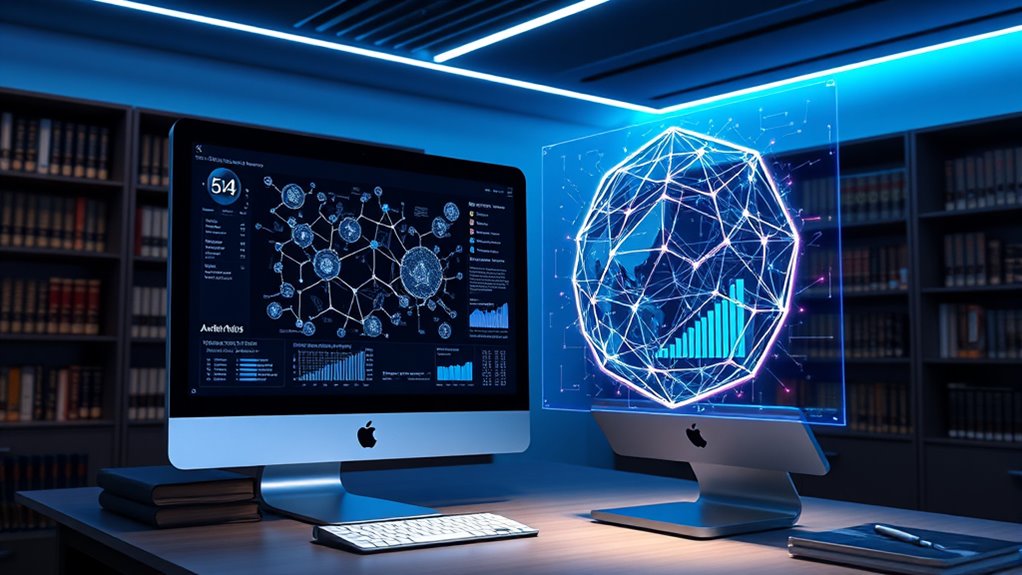AI supports antitrust investigations by quickly analyzing large data sets to spot suspicious patterns and behaviors, like collusion or price-fixing. It streamlines the process, saving time and reducing the need for manual reviews. AI tools can uncover irregularities in transactions and analyze emails or documents for relevance. Although it boosts investigation efficiency, understanding its ethical and regulatory implications is essential. Keep exploring to see how AI shapes the future of market fairness.
Key Takeaways
- AI rapidly analyzes large transactional data sets to detect anomalies like price-fixing and collusion.
- Natural language processing helps review emails and documents for relevance and suspicious activity.
- AI accelerates investigations by quickly identifying irregularities, reducing manual review time.
- Oversight challenges include AI’s complexity and potential covert collusion, requiring advanced regulatory strategies.
- Transparency and disclosure of AI tools are essential for fair enforcement and preventing market dominance.

Have you ever wondered how artificial intelligence is transforming antitrust investigations? AI is revolutionizing the way regulators detect and analyze anticompetitive behaviors, making investigations faster and more precise. Traditional methods often rely on manual data reviews, which can be time-consuming and limited in scope. Now, with AI, agencies can sift through vast amounts of data quickly, pinpointing suspicious patterns that might otherwise go unnoticed. This capability enables investigators to identify potential wrongdoing, such as price-fixing, collusion, or discriminatory pricing, with greater accuracy. AI tools analyze years of transactional data, uncovering anomalies like irregular payments or unauthorized disbursements that could signal illicit activities.
AI accelerates antitrust investigations by quickly detecting suspicious patterns like price-fixing and collusion, improving accuracy and efficiency.
As AI’s detection capabilities improve, regulatory agencies like those in the US are increasingly focused on its potential anticompetitive effects. They’re concerned about how AI-driven data aggregation and decision-making might concentrate market power, especially when a few tech giants dominate the landscape. Companies like OpenAI and Microsoft control around 69% of the AI model and platform market share, creating considerable barriers for smaller firms trying to compete. This market dominance raises questions about fair competition and whether AI tools could facilitate practices like predatory pricing or market manipulation, which harm consumers and smaller businesses alike.
AI’s role isn’t limited to detection; it also enhances investigation efficiency. For example, natural language processing (NLP) techniques allow AI to analyze emails and documents in context, predicting their relevance to ongoing cases. This rapid analysis helps investigators focus on the most critical materials, reducing investigation time considerably. AI can also identify irregularities in transactional data, flagging suspicious payments or alterations that might indicate collusion. Its ability to process complex data patterns surpasses human capacity, enabling regulators to respond more swiftly to antitrust concerns. Furthermore, advancements in home theatre projectors highlight how sophisticated technology can improve user experiences, exemplifying the power of AI-driven innovation across different sectors. Additionally, understanding the market concentration facilitated by AI tools is crucial for regulators to prevent unfair dominance. Moreover, the transparency of AI algorithms remains a key challenge, as many systems operate as “black boxes,” making it difficult for regulators to understand their decision-making processes. As AI becomes more prevalent, the importance of ethical AI practices in enforcement is gaining recognition to ensure fair and unbiased investigations.
However, the integration of AI into investigations introduces challenges. The covert and complex nature of AI systems makes it difficult to detect when they’re being used for anticompetitive purposes. Algorithms may tacitly facilitate collusion, making enforcement more complicated. Additionally, transparency issues arise when AI technologies are not fully disclosed during merger reviews, complicating efforts to ensure fair competition. It is also important for regulators to stay updated on regulatory frameworks that govern AI deployment, as evolving policies can impact enforcement strategies. For regulators to effectively oversee AI’s influence, they need to develop advanced technical strategies and require companies to disclose their AI tools, ensuring transparency. Overall, AI offers immense potential to strengthen antitrust enforcement, but it also demands careful oversight to prevent misuse and maintain a level playing field.
Frequently Asked Questions
How Does AI Identify Collusive Pricing Strategies?
You’re curious about how AI spots collusive pricing strategies. AI analyzes large datasets to detect unusual patterns, such as synchronized price changes or deviations from normal market behavior. It recognizes similarities across competitors’ pricing, identifies anomalies, and predicts potential collusion areas. By processing data quickly and accurately, AI helps investigators uncover subtle signals of collusion that might be missed with manual analysis.
What Are Ai’S Limitations in Detecting Market Dominance?
You might wonder about AI’s limitations in detecting market dominance. AI struggles with transparency, making it hard to understand how decisions are made. It also faces challenges with incomplete or biased data, which can obscure true market power. Additionally, AI can be used covertly for anti-competitive practices, and its technical complexity requires specialized expertise. These factors make it difficult for you to rely solely on AI to identify dominant firms accurately.
Can AI Predict Future Antitrust Violations?
Sure, AI can predict future antitrust violations—if only it could perfectly see the future. In reality, it analyzes historical data and market trends, so predictions aren’t foolproof. You might get early warnings, but false positives and unknown variables still challenge its accuracy. While AI improves over time, it’s not a crystal ball. Use it as a tool, not a guarantee, to anticipate potential violations.
How Is AI Integrated With Human Investigative Processes?
You integrate AI with human investigative processes by using it to analyze large datasets, identify patterns, and flag anomalies that might indicate violations. AI automates routine tasks like document review and data collection, freeing you to focus on complex analysis. It also provides decision support, enhances collaboration through shared insights, and streamlines reporting, making your investigations more efficient and accurate while allowing you to interpret AI findings within the broader context of your expertise.
What Are Ethical Concerns With Using AI in Investigations?
You should consider that using AI in investigations raises ethical concerns like bias and discrimination if the data isn’t fair. Privacy issues also come up as AI handles sensitive information, risking misuse. Transparency is another problem—AI decisions can be opaque, making accountability tough. Plus, there’s the risk of reinforcing market power and anticompetitive behavior, which can harm consumers and smaller firms. Ensuring ethical AI use is essential for fair, trustworthy investigations.
Conclusion
As you harness AI in antitrust investigations, you’re opening the door to a sharper, more insightful future. AI acts like a detective’s magnifying glass, revealing hidden patterns and connections that might otherwise stay in the shadows. Embracing this technology empowers you to navigate complex markets with greater clarity and precision. With AI by your side, you’re not just keeping pace—you’re illuminating the path toward fairer, more competitive economies.











